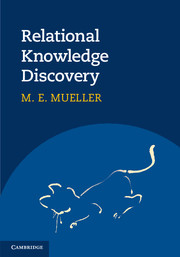2 - Relational knowledge
Published online by Cambridge University Press: 05 July 2012
Summary
Talking about the discovery of knowledge requires us to understand “knowledge” first. In the last chapter we defined knowledge to be what it takes to discriminate different things from each other.
In this chapter we will develop a more formal framework of knowledge structures that enables us to describe the process of discovering new knowledge.
Information is something that may change knowledge, and knowledge is the ability to relate things by putting a structure on them. Knowledge is not made from the things we put into order, and information does not change the things themselves. It is, rather, that knowledge is a set of relations describing things and information helps us to describe a relation's utility for classifying things. But, then, why do we assume information to be describable by a set of entities each of which can take a certain number of different states – if they do not know whether there are entities they have never seen before nor how many states the entities can possibly take? Why do we explain causality by means of probabilistic dependence?
There are many definitions of what knowledge could be, and there are many approaches to knowledge representation formalisms. They all agree that there is knowledge of different qualities: factual knowledge, weak knowledge, procedural knowledge, hard knowledge, motor knowledge, world knowledge, and behavioural knowledge are just a few. A sloppy and weak definition of knowledge might well be what we want to acquire by learning.
- Type
- Chapter
- Information
- Relational Knowledge Discovery , pp. 17 - 37Publisher: Cambridge University PressPrint publication year: 2012
- 1
- Cited by



